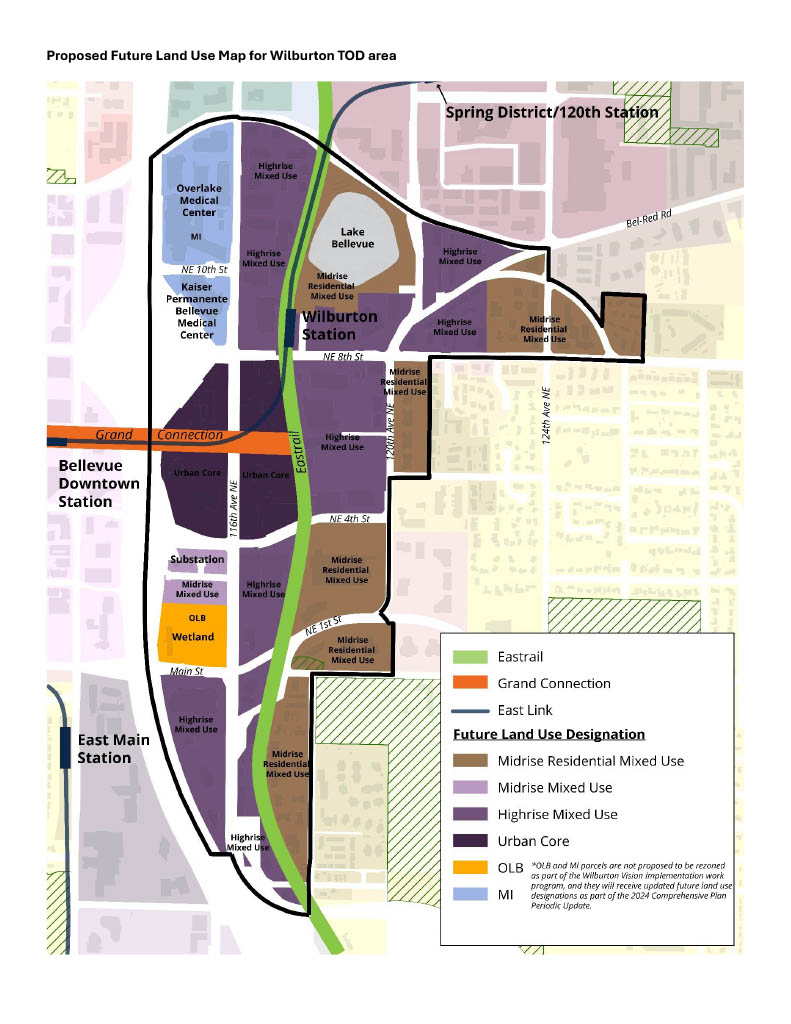Bellevue Opens Wilburton to Life Science: Flexible Code, Fee Reductions, and Transit-Oriented Mixed Use
The City of Bellevue has finalized a major land use update to reposition the 300-acre Wilburton Transit-Oriented Development (TOD) district, historically auto-oriented with car dealerships, as a dense, mixed-use neighborhood that explicitly accommodates life science R&D. The update establishes new mixed-use districts, incentives, and building standards intended to catalyze near-term investment next to light-rail stations and the Eastrail corridor.
Bellevue, Washington, Greater Seattle’s second largest city, is just 10 miles (16 km) away from Seattle. Recognized as a global technology hub, the city combines a concentration of Fortune 500 companies with a vibrant startup ecosystem. Bellevue also hosts the second-largest cluster of life science companies in Washington State. With its proximity to leading research institutions such as the University of Washington and Fred Hutchinson Cancer Center, Bellevue is leveraging its economic strength to create new opportunities for growth in the life science industry.
What’s new for life science development projects
The City of Bellevue has updated its land use codes to make Life Science development more attractive in the Wilburton area.
- Life-science-specific height allowances (on top of base limits). Mechanical and rooftop systems can extend up to 45 feet above building height limits for medical/life science uses (30 feet for general mechanical), recognizing larger air handling and specialized equipment needs.
- Floorplate flexibility. “Floorplate” refers to the area a single floor of a building occupies. In Wilburton, most floors are limited to about 30,000 square feet, but life science projects are exempt from that cap, allowing larger, more efficient layouts to accommodate labs, GMP facilities, and specialized equipment.
- Fee relief to accelerate delivery. Through Bellevue’s Commercial Catalyst Program, non-residential in-lieu fees are reduced 50% for developments containing life science or medical office uses that vest prior to June 1, 2028.
- Districtwide eligibility. The LUCA (Land Use Code Amendment) implements new mixed-use districts across the ~300-acre Wilburton area, with life science treated as an allowed use and given tailored standards noted above.
Where this is happening
The plan frames Wilburton as a transit- and trail-connected extension of Downtown Bellevue, fastened by the Bellevue Downtown and Wilburton stations on Sound Transit’s 2 Line and the Eastrail multi-use corridor (see the Land Use Map).
Why it matters: workforce and ecosystem advantages
Greater Seattle is a top U.S. life science region with deep research, talent, and funding:
- NIH funding: In FY 2024, Seattle-area organizations received $1.1B+ from the National Institutes of Health (9th-highest nationwide), supporting a robust pipeline of basic and translational research.
- Jobs & growth: Bellevue is home to 3,805 life science jobs, reflecting 17% growth from 2019 to 2024 and a projected 16% additional growth from 2024 to 2029.
- Bellevue healthcare tenants: The city is already home to major healthcare providers and tenants including Overlake Medical Center & Clinics (a 349-bed hospital now part of MultiCare Health System), Kaiser Permanente Bellevue Medical Center, Seattle Children’s, UW Medicine Eastside Specialty Center, and a growing cluster of medical office buildings and specialty clinics. These assets position Bellevue as a natural expansion point for life science R&D.
- Institutional anchors: The University of Washington, Fred Hutchinson Cancer Center, Seattle Children’s, and the Allen Institute underpin regional discovery and commercialization.
Bellevue’s Wilburton code update pairs purpose-built flexibility for labs and GMP (mechanical height and floorplate relief) with near-term fee reductions to de-risk projects, right next to light rail and Eastrail. For developers looking for life science commercial projects and life science companies evaluating expansion, Wilburton now offers a policy environment aligned with the technical requirements and speed-to-market pressures of life science development.
Sources & references
- City of Bellevue, Wilburton Vision Implementation project overview and 300-acre TOD area. https://bellevuewa.gov/city-government/departments/community-development/planning-initiatives/wilburton-vision
- City of Bellevue, LUCA Overview (7/18/2024) life-science mechanical height allowances and floorplate exemptions. https://bellevuewa.gov/sites/default/files/media/pdf_document/2024/luca-overview_7.18.24.pdf
- City of Bellevue, Ordinance 6846 Commercial Catalyst Program fee reductions, including 50% for life science/medical office uses through June 1, 2028. https://bellevuewa.gov/sites/default/files/media/pdf_document/2025/ord-6846.pdf
- City of Bellevue, Proposed Future Land Use Map (FLUM) stations, Eastrail, and district land use designations. https://bellevuewa.gov/sites/default/files/media/pdf_document/2024/3_Wilburton%20FLUM.pdf
- CBRE, Global Life Sciences Atlas – Seattle FY2024 NIH funding and ecosystem anchors. https://www.cbre.com/insights/local-response/global-life-sciences-atlas-market-profiles-seattle
- Life Science Washington, 2025 Economic Impact Report employment and wage figures. https://lifesciencewa.org/wp-content/uploads/2025/04/2025-Economic-Impact-Report.pd

Ready to take advantage of everything Greater Seattle has to offer?
